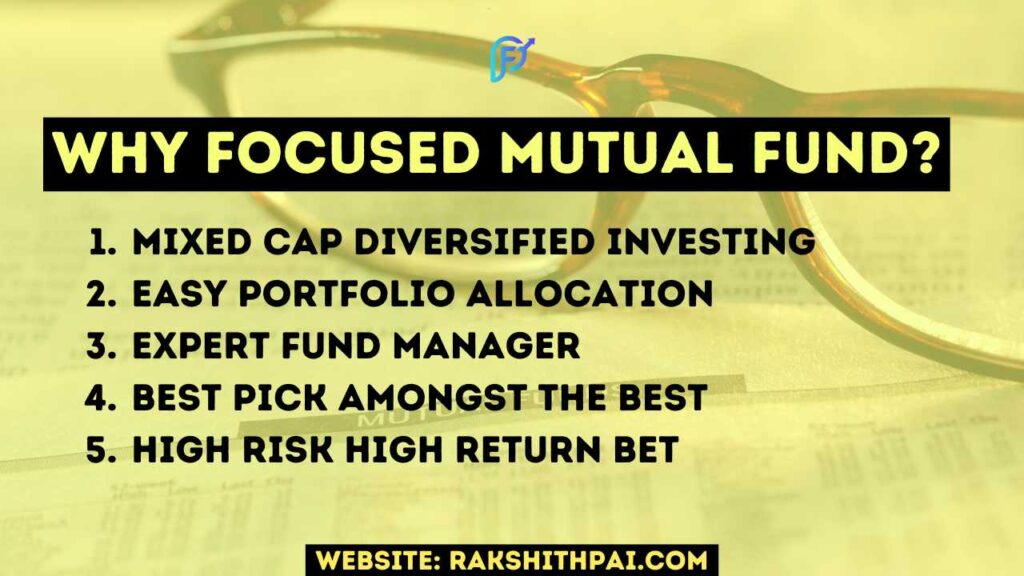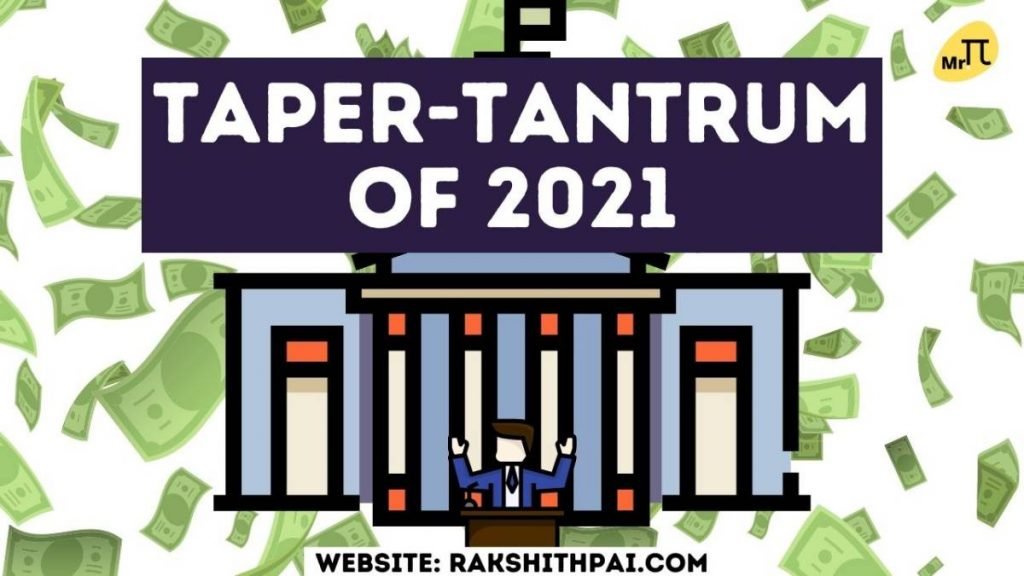Table of Contents
What Are Focused Funds?
A focused fund is a type of mutual fund that invests in a select group of equities. Focused funds are permitted by the Security and Exchange Board of India (SEBI) to own a maximum of 30 companies in their portfolio. So, a “focused fund” is a type of investment vehicle that puts its money into no more than 30 stocks. Because of such a restriction, a highly concentrated portfolio is built.
While other funds may hold up to 100 stocks, this one is the only mutual fund with such restrictions. Depending on their emphasis, funds can narrow down to investing in either large, mid or even small-cap stocks.
They do not diversify their holdings across several stocks but instead put all of their eggs in one basket. An objective of a concentrated mutual fund is to maximize returns by allocating capital to high-yielding stocks.
Why Invest in a Focused Fund?
The promotion of equity investment via diversification is one of the primary benefits of investing in conventional mutual funds. Because of the time and effort required to individually choose each investment, most mutual funds instead invest in a large number of firms with predetermined weights. Diversification lets investors get the most out of their investments while minimizing risks and volatility, but it also has some drawbacks.
Multi-Asset Allocation Mutual Fund & Its Importance:
Diversifying across different industries and businesses, for example, might lower the overall return on investment because not every business will do well at the same time.
Focused mutual funds often diversify their assets among a smaller number of thoroughly vetted equity and debt funds. These funds don’t use diversification as other funds do. Instead, they do a lot of research to pick winning stocks.
As a result, the returns from these funds are seen as more uncertain. Investments in these vehicles are riskier than those made by mutual funds that pool together money to buy a large number of equities, but the potential rewards are greater as well. They are also sometimes called “under-diversified funds” or “concentrated funds.”
For example:
If you invest in 1 company, you are supposed to read 4 quarterly reports and 1 annual report, totaling 5 such reports, and that’s excluding other notifications, such as meetings from management, news reports, CS and CA notifications, etc.
With a 15-company portfolio, you are supposed to go through 75 such reports. Imagine the amount of work you are required to go through with an additional company in your portfolio.
The same applies to mutual funds. Even though they are equipped with all the resources required both in terms of manpower and technical support, these fund houses cannot provide a return that exceeds the broad market average. That’s when we need to dial down our viewpoint and pick a niche.
A niche of 20 to 30 stocks in a portfolio. One that’s easy to manage while reducing the overall risk and proving better than the market average return.
I practice Focused Fund Investing, and my portfolio contains no more than 35 stocks.
Factors to Know About Focused Mutual Fund:
The following are the factors you must be aware of before subscribing to any focused mutual fund;
High Stake
Principal loss is possible because focus funds limit their portfolio to no more than 30 stocks. Investing all of that cash in just a few equities necessitates substantial stakes in each of those companies.
For instance, with a 25-stock portfolio, on average, a fund manager must allocate 4% of the fund to one stock. You may be unaware that 10% to 15% of the companies in a portfolio typically carry 70% to 80% of the portfolio weightage.
But, when the option to diversify is limited to just 20 to 30 stocks, the fund manager must allocate more to the same company he/she has been holding for a long time. Such a decision may or may not turn out well for the unit holders.
This lack of true diversification is what exposes the funds to concentrated risk. The risk associated with these products is higher than that of more diversified mutual funds like multi-cap funds.
Risk
The maximum number of stocks a focused fund can own in its portfolio is under 30. So, such concentrated exposure will create a separate kind of risk that is usually taken care of by other mutual funds via diversification.
Investing a few thousand rupees in a few companies is one thing, but investing crores of rupees in a few hand-picked, selective companies is entirely different. And since the maximum amount of stock with a limit of 30 may be purchased, it presents significant danger. Therefore, you should only invest if you can stomach a significant degree of uncertainty.
Also, Since the assets of a focused fund are divided across a smaller number of equities, the value of those holdings may fluctuate more rapidly in the near term. Accordingly, this may not be the best choice if you’re looking for a short-term investment. A longer-term investment horizon is required (at least 5 years).
Return
In polarised markets, the returns of a focus fund may be higher than those of a diversified fund or the market as a whole. When the market is polarised, just a small number of stocks are responsible for the market’s growth, while the vast majority of stocks on the market stagnate.
You may expect massive profits if the stocks chosen by the focus fund are among those few. On the other hand, you may not even beat the market average with the risk you are taking if the market surge is broader in scope.
Maximize Your Mutual Fund Investing Returns:
Expense
The expense ratio quantifies the proportion of your mutual fund’s total costs that goes toward the fund’s administrative costs. Keep an eye out for funds with a low expense ratio, since this can increase your actual returns. For this reason, while deciding which targeted funds to invest in, it’s important to consider the fund’s expense ratio.
Special consideration must be shown when selecting a focused fund because here, the fund manager is showing additional due diligence in selecting the best amongst the best in his/her view that could achieve a better result. And, since such a pick is just 20 to 30 stocks out of the vast majority of options, the fund manager might expect to pass on an added cost to you.

Advantages of Focused Funds:
- A focused fund can invest in a diversified market cap. Thus, the fund can own large, mid-cap, and even small-cap companies in its portfolio.
- Portfolio allocation and redistribution are done easily with just 20 to 30 stocks to re-adjust.
- The expertise of a professional fund manager who picks the best amongst the best 30 companies out of the 7500 odd companies listed on the market.
- High expected return due to concentrated portfolio with increased weightage among securities.
- Since the entire portfolio is limited to 30 stocks, a watchful eye is maintained, and when underperformers notice, it is immediately rectified.
Disadvantages of Focused Funds:
- Most of the focused fund investments are high-stakes bets because they invest more than 5% or even 10% of their portfolio in a single company.
- A focused fund is more volatile than other regular mutual funds.
- Due to increased volatility, these types of investments are not suggested for short-term investors.
Tax Implication under Focused Fund Investing:
Focused mutual fund investments are taxed in the same way as any other equity fund. Your investment profits over a period of more than a year (investments held for more than 12 months) will be considered Long-Term Capital Gains (LTCG) and taxed at a rate of 10%.
This applies only if your yearly profits are more than Rs 1 lakh. And, if you sell your investment position in less than a year, you will be subject to short-term capital gains (STCG) tax at a rate of 15%.
15 Best Ways to Save Income Tax in India:
Top 5 Best Performing Focused Mutual Fund:
The Focused Fund is a long-term investment tool. It is suggested for only those who have an interest in staying invested for a period of 5 to 7 years or more. The below list returns are based on 5-year returns.
| Sl No | Scheme Name | 1 Year Return | 3 Year Return | 5 Year Return |
|---|---|---|---|---|
| 1 | IIFL Focused Equity Fund | 0.02% | 24.51% | 16.36% |
| 2 | Quant Focused Fund | 11.42% | 27.55% | 15.32% |
| 3 | SBI Focused Equity Fund | -1.49% | 20.76% | 15.07% |
| 4 | Nippon India Focused Equity Fund | 6.75% | 24.70% | 14.49% |
| 5 | Franklin India Focused Equity Fund | 7.07% | 22.45% | 14.36% |
Conclusion:
With a limit of 30 equities, Focused Equity Funds are a type of equity mutual fund that invests at least 65% of its assets in equities and equity-related products. They are able to invest across market caps, industries, and even countries. High conviction equities account for a disproportionate share of the portfolio’s weight. Therefore, such funds are anticipated to have exceptionally high long-term return potential.
There is a lot of emphasis placed on mutual funds’ suitability for portfolio diversification. Mutual funds, on the other hand, are structured to invest in a basket of stocks with predetermined weights, relieving investors of the burden of making individual investment decisions. By spreading their bets over many stocks, investors can gain exposure to the equity risk premium with less volatility and less risk.
Although diversity can reduce risk, it can also reduce potential returns by distributing capital among firms or industries that aren’t all winners. If an investor is sure that one industry or market segment will do better than the market as a whole, they can make the most money by focusing on that one industry or market segment.
Disclaimer: All the information on this website is published in good faith and for general information purposes only.









